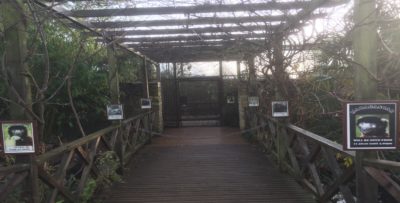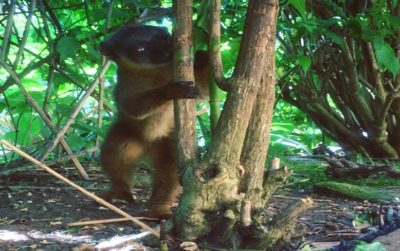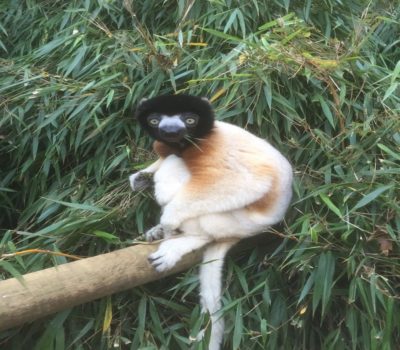Welcome!

Hello fellow Lemur fans. I’ve been looking into areas where I can help, so here I am. This is my first time blogging so here we go. I’m Liam, a volunteer at the Cotswold Wildlife Park & Gardens. Many of you may not have heard of this park and but it’s an amazing park, located by the sleepy Cotswold town of Burford, England.
My Work as a Volunteer
My day begins by reporting to the primate keepers during their break, around 10am. We generally talk about our week, and the keepers report on any interesting behaviour and have a team discussion about the animals in the section. The lemur keeper will catch up with the volunteers to inform us on what the day may hold in regards to animal encounters, if they would like us to observe a particular individual to observe their behaviour, and what jobs can be done throughout the day. My first job of the day is to clean and maintain the walkthrough to ensure we have a hygienic and aesthetically pleasing exhibit for our animals as well as our visitors.
The keepers have very busy days, so anything I can do to help is greatly appreciated. Once the walkthrough is open, my main priority is monitoring visitor/animal interactions and ensuring our visitors have an educational and enjoyable experience.
The three golden rules in the walkthrough are: 1) No food or drink in the open, 2) No touching of the lemurs, and 3) Ensure that only one gate is open at a time when you enter/exit.
I answer visitor questions about the individual lemurs we have at the park as well as about our conservation efforts in Madagascar.
This was hard on my first day, as I didn’t know an awful lot, but through research and asking my own questions I’ve learnt so much. I found it difficult to identify all of the lemurs initially, but spending my Sundays with them I’m happy to say I’m getting there.

So what animals are here at Cotswold Wildlife Park?
As well as the 11 Ring-tailed Lemurs, 3 Collared Lemurs and a Crowned Sifaka that I work with, you can also find 3 Radiated tortoises which join us in the summer months (they live in the reptile house through the winter), 2 Purple Swamphens, 5 Madagascan teal, 4 White-faced whistling ducks and 4 Sacred Ibis.
You can also see 3 Greater Bamboo lemurs and 3 Belted black and white ruffed lemurs from within the walkthrough. Elsewhere around the park, you will find our 22 Grey Mouse Lemurs, 2 Crowned Lemurs, and 2 other Crowned Sifaka. The Grey Mouse Lemurs are nocturnal so are found in the Siamang house in a nocturnal exhibit.
The Collared Lemurs at Cotswold
In Madagascar, these lemurs can be found in the South East of the island. The park has 3 Collared Lemurs, including the breeding female, Anais, the breeding male, Varika, and their daughter, Birdie.
The Collared Lemurs rule the roost in the walkthrough, being dominant over the Ring-tails thanks to their boisterous nature. Mum and dad are showing young Birdie the ropes in regards to where to climb and how to behave.
Birdie is very playful.
My favourite Birdie story is when she was younger and started to explore away from mum. If she felt a little anxious she would jump on mum for safety and support. One Sunday, Birdie—in a panic—jumped on a ring-tailed lemur by mistake! The terror in both Birdie’s and the Ring-tails eyes was clear to see. Birdie was able to quickly jump off and return to mum unscathed.
Lemur Conservation
Sadly, Lemurs are the most threatened group of mammals on the entire planet. Almost all Lemur species are classified as Vulnerable, Endangered or Critically Endangered on the IUCN red list of threatened species. This is mainly due to deforestation with around 95% of Madagascar’s forests being destroyed over the last 60 years. Lemurs have a few natural predators, the biggest being the Fossa but also Ring-tailed Mongoose and some birds of prey have been known to snatch Lemurs from the tree tops.
It’s a very sad situation we are in. But, there are great conservation efforts such as Sifaka Conservation, HELPSIMUS, The Lemur Conservation Foundation, and of course the Lemur Conservation Network (I could literally keep listing these generous organisations), who not only work with Malagasy communities to promote sustainable agriculture and education, but they also work with Madagascar’s government to educate and gain their support to ensure both Lemurs and the communities can cohabit peacefully.
How easy is it to volunteer at a zoo?
I have no qualifications in animal care or behaviour (yet), but if you’re willing to help in any way you can and are eager to learn it’s very easy. I’m lucky as I live an hour away from two zoos, a wildlife park, and a monkey haven. You have to put the research in.
Contact your local zoos to enquire if volunteering is possible.
Volunteers are generally in great demand if there is space. If not, ask to be put on a waiting list. For me, this is a magical experience, and something I never dreamed I could do. But now this is all I want to do.
Join me next time on ‘A Lemur’s Apprentice’, when I’ll be discussing the newest addition to the walkthrough a Crowned Sifaka called Maitso.

Why didn’t you start with me?!
